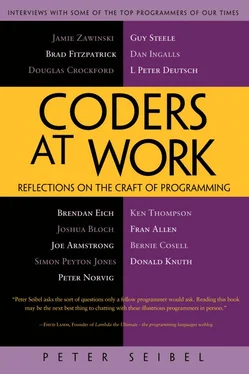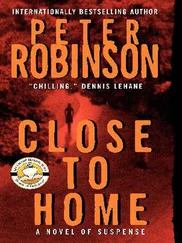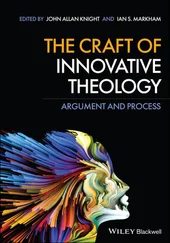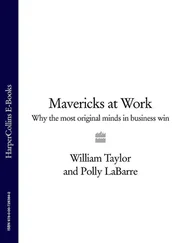Peter Seibel - Coders at Work - Reflections on the craft of programming
Здесь есть возможность читать онлайн «Peter Seibel - Coders at Work - Reflections on the craft of programming» весь текст электронной книги совершенно бесплатно (целиком полную версию без сокращений). В некоторых случаях можно слушать аудио, скачать через торрент в формате fb2 и присутствует краткое содержание. Жанр: Программирование, на английском языке. Описание произведения, (предисловие) а так же отзывы посетителей доступны на портале библиотеки ЛибКат.
- Название:Coders at Work: Reflections on the craft of programming
- Автор:
- Жанр:
- Год:неизвестен
- ISBN:нет данных
- Рейтинг книги:3 / 5. Голосов: 1
-
Избранное:Добавить в избранное
- Отзывы:
-
Ваша оценка:
- 60
- 1
- 2
- 3
- 4
- 5
Coders at Work: Reflections on the craft of programming: краткое содержание, описание и аннотация
Предлагаем к чтению аннотацию, описание, краткое содержание или предисловие (зависит от того, что написал сам автор книги «Coders at Work: Reflections on the craft of programming»). Если вы не нашли необходимую информацию о книге — напишите в комментариях, мы постараемся отыскать её.
Coders at Work
Founders at Work
Coders at Work: Reflections on the craft of programming — читать онлайн бесплатно полную книгу (весь текст) целиком
Ниже представлен текст книги, разбитый по страницам. Система сохранения места последней прочитанной страницы, позволяет с удобством читать онлайн бесплатно книгу «Coders at Work: Reflections on the craft of programming», без необходимости каждый раз заново искать на чём Вы остановились. Поставьте закладку, и сможете в любой момент перейти на страницу, на которой закончили чтение.
Интервал:
Закладка:
Seibel:When did you learn to program?
Eich:I was a physics major as an undergraduate at Santa Clara in the late ’70s, early ’80s. We used to go over to Stanford and hack into LOTS-A and LOTS-B, which were the two big timesharing DEC TOPS-20 systems and Santa Clara had a TOPS-20 system: a nice 36-bit processor from DEC, great OS, wonderful macro assembler. C is “portable assembler” but the macro processing is terrible, whereas back then you had real macros for assembly and you could do a lot of fairly structured programming if you were disciplined about it. No type system, but C doesn’t have much of one to speak of. And a rich set of system calls, system services, memory-mapped I/O, all the stuff that didn’t make it into Unix originally.
I was doing physics but I was starting to program more and I was liking the math and computer-science classes I was taking, dealing with automata theory and formal languages. At that point there was a research race to develop the best bottom-up parser generator, what yacc was doing and others would do. It was easy to see the formal purity translate into fairly clean code, which has almost always been the case with the front end of compiler construction. The back end back then was a mess of lore and heuristics, but I really liked the formal language theory and the theory of regular languages and so on.
Seibel:And what languages and environments were you programming in—presumably in physics you were doing Fortran?
Eich:That’s the funny thing. I was so pure physics, I wasn’t taking the engineering classes that would’ve had me carrying the deck and risking spilling it and using the collator. I actually bypassed Fortran. Pascal was big then and we were getting into C. And assembly. So I was doing low-level coding, writing assembly hash tables and stuff like that. Which was good. You get better appreciation for different trade-offs. You can tell the programmers who’ve actually been down to bit-banging level versus the ones who’ve been shielded all their lives.
I also was interested in C and Unix but we were only just getting into it with this old DEC iron. We had the Portable C Compiler yacc-based mess and we were just starting to generate code and play around with Unix utility porting. Since physics wasn’t getting me summer jobs and I was doing a lot of hacking and being a lab assistant I ended up switching in my senior year to math/computer science, and that’s what I got my undergraduate degree in.
Seibel:What was the first interesting program that you remember writing?
Eich:This is going to be embarrassing. There was a terrible graphics terminal DEC made; it was like an evolution of VT100 because it understood the escape sequences, but it also had some pathetic color depth and some sort of early ’80s resolution. So I started writing game knockoffs for it: Pac-Man, Donkey Kong. I wrote those games in Pascal and they emitted escape sequences. But it was kind of hobby programming that grew and grew. I think that was the first nontrivial programming I did where I had to think about modularity and protecting myself.
This was while I was a physics major, probably third year. Fourth year I became math/computer science and I was starting to study formal languages and write parser generators. So those were the kinds of programs I wrote: either games or serious nerd parser generator type programs. Then I started thinking about compilers and writing macro processor knock offs, like m4 knockoffs or CPP knockoffs. I remember when we got some version of the Unix source and reading some of the really crufty C code. The John Reiser C preprocessor—probably the original—was just an amazing mess. It was very efficient; it was using a global buffer and it was a huge pointer stew, and it would try to avoid copying. I thought, “There has to be a better way to do this.”
So that’s how I ended up getting out of physics and into computer science and programming. I wasn’t really programming before that; it was all math and science. My parents didn’t let me get an Apple II. I tried once. I didn’t beg but I was saying, “I could learn a foreign language with this,” which was a complete smoke screen. “No. You’ll probably waste time playing games.” And they were right. So they saved me from that fate.
Seibel:Other than providing more summer employment than physics, what about programming drew you in?
Eich:The connection between theory and practice, especially at the front end of the compiler construction process, was attractive to me. Numerical methods I didn’t get into too much. They’re less attractive because you end up dealing with all sorts of crazy trade-offs in representing real numbers as finite precision floating-point numbers and that’s just hellish. It still bites JavaScript users because we chose this hardware standard from the ’80s and it’s not always operating the way people expect.
Seibel:Because, like the Spanish Inquisition, no one really expects floating point.
Eich:No one expects the rounding errors you get—powers of five aren’t representable well. They round badly in base-two. So dollars and cents, sums and differences, will get you strange long zeros with a nine at the end in JavaScript. There was a blog about this that blamed Safari and Mac for doing math wrong and it’s IEEE double—it’s in everything, Java and C.
Physics was also less satisfying to me because it has kind of stalled. There’s something not quite right when you have these big inductive theories where people are polishing corners and inventing stuff like dark energy, which is basically unfalsifiable. I was gravitating toward something that was more practical but still had some theoretical strength based in mathematics and logic.
Then I went to University of Illinois Champaign-Urbana to get a master’s degree, at least. I was thinking of going all the way but I got stuck in a project that was basically shanghaied by IBM. They had a strange 68020 machine they had acquired from a company in Danbury, Connecticut, and they ported Xenix to it. It was so buggy they co-opted our research project and had us become like a QA group. Every Monday we’d have the blue suit come out and give us a pep talk. My professors were kind of supine about it. I should’ve probably found somebody new, but I also heard Jim Clark speak on campus and I pretty much decided I wanted to go work at Silicon Graphics.
Seibel:What were you working on at SGI?
Eich:Kernel and networking code mostly. The amount of language background that I used there grew over time because we ended up writing our own network-management and packet-sniffing layer and I wrote the expression language for matching fields and packets, and I wrote the translator that would reduce and optimize that to a short number of mask-and-match filters over the front 36 bytes of the packet.
And I ended up writing another language implementation, a compiler that would generate C code given a protocol description. Somebody wanted us to support AppleTalk in this packet sniffer. It was a huge, complex grab bag of protocol syntax for sequences and fields of various sizes and dependent types of… mostly arrays, things like that. It was fun and challenging to write. I ended up using some of the old Dragon book—Aho and Ullman—compiler skills. But that was it. I think I did a unifdef clone. Dave Yost had done one and it didn’t handle #ifexpressions and it didn’t do expression minimization based on some of the terms being pound-defined or undefined, so I did that. And that’s still out there. I think it may have made its way into Linux.
Читать дальшеИнтервал:
Закладка:
Похожие книги на «Coders at Work: Reflections on the craft of programming»
Представляем Вашему вниманию похожие книги на «Coders at Work: Reflections on the craft of programming» списком для выбора. Мы отобрали схожую по названию и смыслу литературу в надежде предоставить читателям больше вариантов отыскать новые, интересные, ещё непрочитанные произведения.
Обсуждение, отзывы о книге «Coders at Work: Reflections on the craft of programming» и просто собственные мнения читателей. Оставьте ваши комментарии, напишите, что Вы думаете о произведении, его смысле или главных героях. Укажите что конкретно понравилось, а что нет, и почему Вы так считаете.












